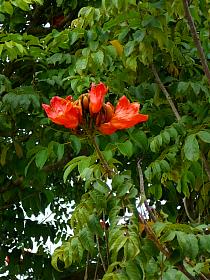African Tulip tree, Flame-of-the-forest, Spathodea Campanulata
 Etymology: its name, African tulip tree comes from its flower, in the form of tulip. Its Latin name comes from Greek " spathê " which means spatula referring to the form of the corolla. Etymology: its name, African tulip tree comes from its flower, in the form of tulip. Its Latin name comes from Greek " spathê " which means spatula referring to the form of the corolla.
Origin: Equatorial Africa, in tropical and subtropic zone. It is also found in Egypt, in the Canary Islands and in Central America.
Habitat: the African Tulip Tree grows on a well drained, sour or neutral rich, cool soil. It tolerates seaside environments. It appreciates sunny position and fears the wind.
Hardiness: zone 11 (he fears frost).
Growth: fast.
Height: 20 m tall.
Shape: globose crown.
Right, sometimes ramified trunk.
Bark: smooth, green grey.
Persistent or semi-persistent foliage (according to climate) dark, bright green. Big leaves (30 - 40 cm), opposite, imparipinnate in 7-19 oval leaflets - acuminate, wavy margin. The young leaves are bronze green.
Flowers: Big flowers (from 7 to 13 cm long), campanulated corolla with 5 toothed and wavy, rounded lobes, 4 stamens, tough calyx, disposed in final and flat racemes, of scarlet-orange red colour with gold yellow rim. They appear from spring to summer. The corolla is swollen in external part. Inflorescences open from the outside to the inside for a period of 3-4 days. The buds are fluffy and green-bronze, when pressed, drops of water appear. Flowers are nectariferous.
Fruits: long brown capsules, dehiscent, oblong (20 cm), endowed with a big quantity of seeds with translucent wings which have a form of heart and scatter in the wind.
Propagation: by seedling or cutting of semi-woody stem or of root segments. The African Tulip Tree has tendency to suckers and can become intrusive.
Uses:
Its wood is very brittle. It is used by the African marabous for the sculpture of amulets. Newly cut, the wood has a garlic smell. It burns hardly.
The bark, flowers and seeds, are used in African traditional medicine: flowers would have properties to treat skin infections and seeds are traditionally used to poison arrows.
|